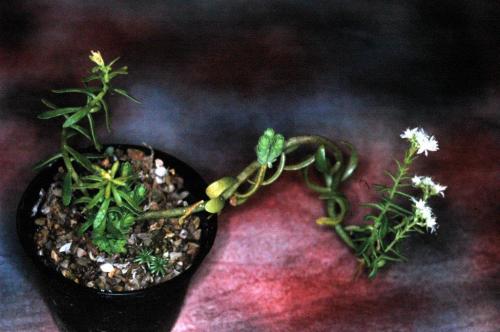ROBERTII Veldk., 2009
Synonym : Sedum multiflorum R.T.Clausen (1978)
Distribution : Mexico (Jalisco); ± 1700 m.
Description (according to 't Hart & Bleij in IHSP, 2003) :
Glabrous perennial ± tufted herbs with tuberous roots and few short sterile stems, 2 - 4 cm tall, very leafy.
Leaves alternate, oblanceolate-linear, obtuse or rounded to truncate, papillose, 11 - 17 x ±3 mm, ± 1 mm thick, spreading.
Inflorescences : flowering branches erect or ascending, papillose, inflorescences many-branched cymes.
FIowers 5-merous, sepals basally free, broadly spurred, nearly equal, lanceolate, obtuse, petals free to the base, lanceolate, subacute to acuminate, narrowly mucronate, papillose, white, anthers red.
Cytology : 2n = 24
Ray Stephenson (Sedum, Cultivated Stonecrops, 1994, p. 257) :
Sedum multiflorum [S. robertii] is a relatively new species to be discovered and introduced to cultivation. Densely leaved basal stems appear each year from a thickened rootstock and gradually elongate to 30 cm (12 in) or more, forming arching inflorescences with white flowers. Of similar habit and closely related to S. wrightii, S. multiflorum [S. robertii] has linear, sessile leaves. Red, fairly brittle stems are a contrast to green glabrous leaves. White stellate flowers are produced in large numbers.
Habitat : This stonecrop has a very limited range, confined to a small area near Cuidad Guzman, Jalisco, in the western section of the Trans-Mexican Volcanic Belt, on shaded hillsides of a canyon.
Main points of distinction : Red, elongating, arching stems with back-arching, downward-pointing leaves terminating in flowers in spring are fairly distinct. Sedum wrightii has petals that are obviously upright in the lower portion while those of S. multiflorum [S. robertii] are spreading. Sepals are free, patent, equal, and somewhat papillose. Petals are eroded, mucronate, and topped with wine-red. Anthers are red.
Variation : Most plants in cultivation have been propagated from I.S.I. 1411.
Horticulture : Easily detached leaves root and produce new plants. Viviparous tufts also form on inflorescences, making propagation easy. This species is very easily rotted if overwatered. I have never been able to produce pretty specimens, but do know that very beautiful plants have been cultivated in hanging baskets. It can withstand a few frosts.

Photo Ray Stephenson